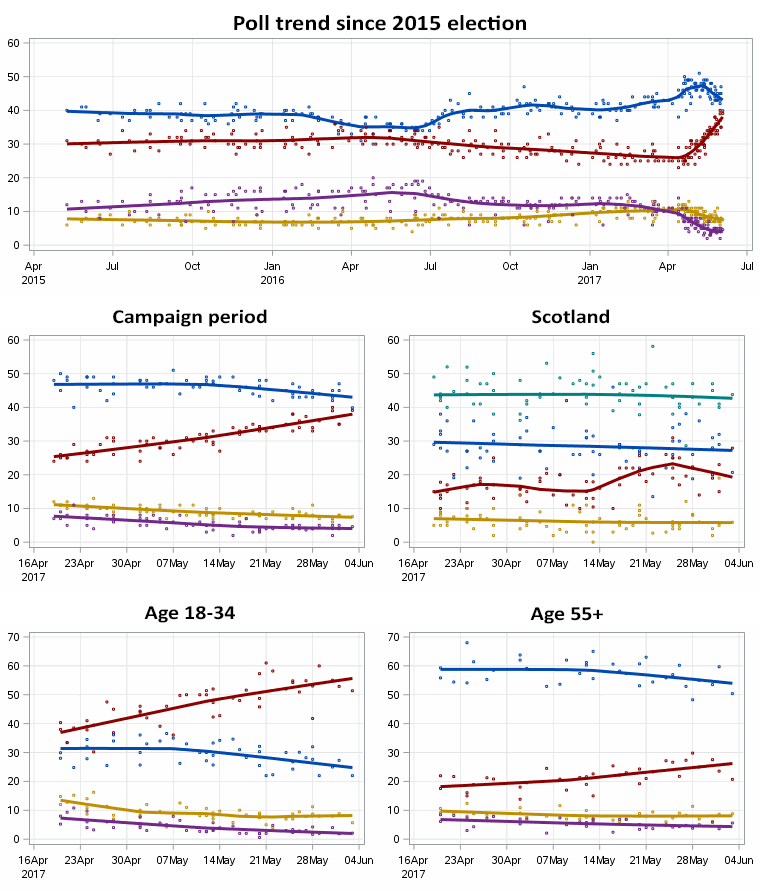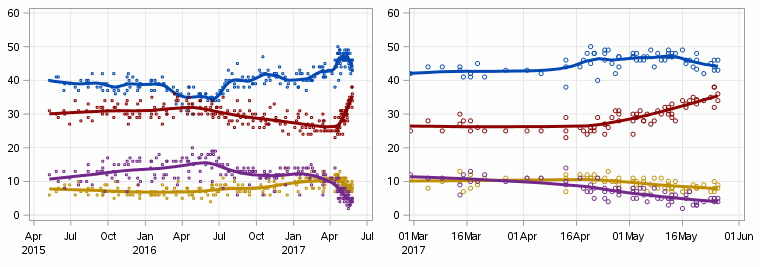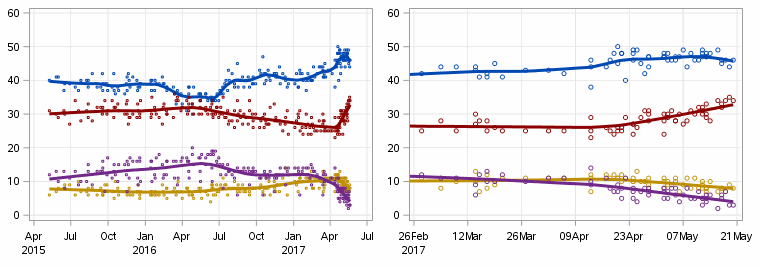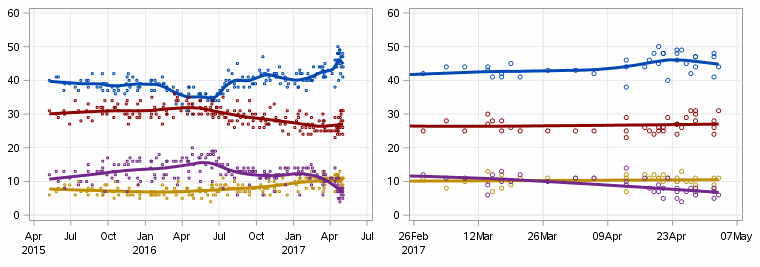Conclusion. I kind of lost interest in live blogging after the previous post, but nearly 24 hours on from the closure of polling, only one seat remains to be declared, and the result if Conservatives 318 (-12), Labour 261 (+29), Scottish Nationalists 35 (-21), Liberal Democrats 12 (+4), Plaid Cymru 4 (+1), Green 1 (-) and, of the Northern Ireland contingent, Democratic Unionist 10 (+2), Sinn Fein 7 (+3) and independent 1 (-). The seat that remains to be called is the normally blue-ribbon constituency of Kensington in London, which is on to its third recount after going down to the wire as a result of the metropolitan backlash against the Conservatives. The first two counts reportedly had Labour winning by 36 and 39 votes. As Sinn Fein members don’t take their seats, the magic number is 322, and the Conservatives will be relying on the Democratic Unionist Party to reach it. Three parties represented in the previous parliament have emerged empty-handed: Northern Ireland’s Social Democratic & Labour Party and Ulster Unionist Party, who won three and two seats in 2015, and UKIP, who won one.
Excluding Kensington, the vote shares are Conservative 42.4% (+5.5%), Labour 40.0% (+9.5%) and Liberal Democrats 7.4% (-0.5%). Line honours among the pollsters clearly go to Survation, whose final poll had it at Conservatives 41.3%, Labour 40.4% and Liberal Democrats 7.8%, which was the narrowest Conservative lead out of the nine pollsters on the British Polling Council. YouGov seemed to have it right earlier, but squibbed it with a late methodology change that herded to the Conservatives, their feelings presumably hurt by this sort of thing. The overall bias of the BPC pollsters to the Conservatives most likely reflected a reluctance to believe the age profile of the voting population would be much different from 2015, whereas Survation were more inclined to take respondents at their word as to whether they would vote. Outside the BPC tent, SurveyMonkey did better than all but one of those within in recording a 42-38 lead to the Conservatives; and Qriously’s 4% error, in this case in favour of Labour, was bettered only by Survation and Kantar.
UPDATE: Mike Smithson of Political Betting points out that the polling figures exclude Northern Ireland, whereas the numbers quoted above do not, and hence dampen the results for all concerned. The proper base from which the pollsters should be judged is Conservative 43.5%, Labour 41.0%, Liberal Democrats 7.6%.
Once again, the exit poll overseen Professor John Curtice more than earned its keep, coming in at 41% apiece for the Conservatives and Labour, and projecting 314 seats for the Conservatives, 266 for Labour, 34 for the Scottish Nationalists and 14 for the Liberal Democrats. Immediate reaction to the exit poll in 2010, 2015 and 2017 was that it surely must be underestimating, respectively, the Liberal Democrats, Labour and Conservatives, but each time it came up smiling.
4.36am. After all the hype, Amber Rudd hangs on in Hastings & Rye.
4.23am. Plymouth, Sutton & Devonport now a declared Labour gain from the Conservatives, overturning a 1.1% margin.
4.20am. Alex Salmond loses his seat of Gordon to the Conservatives, in another blow to the SNP.
3.57am. Northern Ireland’s Labour-aligned party has now lost all of its three seats.
3.50am. Lineball result in Amber Rudd’s seat of Hastings leads to recount.
3.37am. Kingston on the fringe of London adds to scattered Liberal Democrats gains around the place from the Conservatives.
3.31am. Someone on BBC says projections point to 3% Conservative lead on the vote, suggesting Survation probably the best performing pollster.
3.29am. Eastbourne another Liberal Democrats gain from the Conservatives.
3.17am. BBC analyst says Labour boilover now expected in Kent seat of Canterbury, with a surge of young voters apparently set to overturn 18.3% Conservative margin. Labour has also gained the Midlands seat of Peterborough (4.1% margin) in a squeaker. In other close result news, the SNP have seen off the Conservatives by 21 votes in Perth & North Perthshire, against the prediction of the exit poll.
3.02am. Labour’s surprise win in the Suffolk seat of Ipswich, mooted earlier in the night, is now confirmed. But in Northern Ireland, the Labour-aligned Social Democratic and Labour Party has lost two of its three seats — one to Sinn Fein, one to the Unionists.
2.59am. Now eight confirmed losses for the SNP: four to the Conservatives, three to Labour, one to the Liberal Democrats. The BBC is projecting them to drop from 56 seats out of 59 to 32.
2.57am. Bristol North West a non-London Labour gain from the Conservatives.
2.54am. Knife-edge Conservative seat of Gower in Wales goes to Labour, not unpredictably. London seat of Twickenham goes from Conservative to the Liberal Democrats, presumably the beneficiary of heavy duty tactical voting.
2.46am. Labour gains Sheffield Hallam from former Liberal Democrats leader Nick Clegg, rated a 33% chance by the exit poll.
2.42am. SNP casualty list lengthens with Liberal Democrat gain of Dunbartonshire East, which was anticipated by the exit poll.
2.38am. Better news for the Conservatives from Southport in north-western England, which they have gained from the Libeal Democrats, which the exit poll rated only a 10% possibility.
2.27am. Midlothian now goes from SNP to Labour, against the prediction of the exit poll.
2.25am. Conservatives win Ochil & Perthshire South, of which exit poll said this: “the Conservatives have a 31% chance of victory, Labour has a 23% chance of victory, the SNP has a 46% chance of victory”. So SNP fairly consistently under-performing the exit poll.
2.19am. Conservatives gain Moray from SNP, as anticipated by exit poll.
2.16am. Conservative ministers confident no more of the exit poll being wrong.
2.11am. Another double-digit swing in London turns the marginal Labour seat of Ealing into a safe one.
2.06am. Stockton South, rated as lineball by the exit poll, goes to Labour.
2.02am. Labour win confirmed in Battersea with 10% swing.
1.58am. Conservatives gain Scottish seat of Angus from SNP — picked by exit poll, but talked up as a shock by the BBC presenter.
1.45am. Another double digit swing to Labour in London, this time in the Conservative seat of Putney. Keep in mind that swings are calculated differently in British parlance, such that a 10% swing overturns a 20% margin. So these results are consistent with Labour being competitive or better in Battersea (15.6%) or even Kensington (21.1%), both the subject of excited Labour chatter.
1.41am. Labour gains Welsh margin Vale of Clwyd with swing of 3.5%.
1.35am. Exit poll looking better now — talk even that Labour will outperform it.
1.30am. Young SNP firebrand Mhairi Black retains Paisley & Renfrewshire South.
1.25am. First result from London is Labour-held Tooting, where Labour gets a swing of 10.6%.
1.20am. The Rutherglen gain by Labour from the SNP was not predicted by the exit poll, which had Edinburgh North & Leith as their only gain in Scotland. BBC pundit says Labour expects to win Sheffield Hallam from former Liberal Democrats leader Nick Clegg — this was too close to call in the exit poll. Other two mooted Labour gains she mentions were anticipated by poll.
1.13am. 4.5% swing to Labour in their safe Welsh seat of Llanelli; Labour narrowly gains Rutherglen & Hamilton West from SNP, the first declared result to change hands.
1.11am. Labour now expecting to make gains in Wales, after disappointing Conservatives failure in Wrexham.
12.59am. I belatedly observe a 1.4% Conservative swing in the north-west England seat of Workington. Someone earlier said the picture got better for the Conservatives with every foot you travelled north.
12.53am. Status quo result in Labour-held north-eastern seat of Durham, where the Conservatives might have vaguely hoped they could still gain based on early results from the region, although 7.7% margin made it a big ask. Still, the sort of seat the Conservatives were expecting to win going into the election.
12.38am. 2.2% swing to Labour in Broxbourne and 0.2% swing in Nuneaton, two middle England seats. But mounting talk of a big result for Labour in London, including a win in Battersea, margin 15.6%.
12.32am. “Entirely possible we will still get an overall majority”, is the less-than-bullish assessment of Conservative heavyweight Liam Fox.
12.28am. 2.6% swing to Labour in Kettering, a Conservative seat in the Midlands.
12.25am. BBC pundit says Labour said to be confident of the Suffolk seat of Ipswich, margin of 7.7%, and four gains in Scotland.
12.21am. Newcastle North swings 0.5% to Labour, which is better than their regional form.
12.16am. Specifically, HuffPost UK politics editor Paul Waugh says Labour is expected to win Kensington, which the Conservatives won 52.2% to 31.1% in 2015.
12.08am. Washginton and Sunderland West swings 2.2% to Conservatives, in line with regional trend. However, there’s excited talk on Twitter about Labour’s prospects in blue-ribbon constituencies in London.
11.59pm. Bad result for Labour from Newcastle Central, good one from North Swindon. Long night ahead.
11.47pm. Third seat is Sunderland South: 2.2% swing to Conservatives. BBC analyst indicates Labour worried exit poll wrong because Conservatives outperforming it on postal votes.
11.33pm. BBC reporter says Labour remain excited about Hastings and Rye, held by Home Secretary Amber Rudd on a margin of 9.4%, which wasn’t picked as a Labour gain by the exit poll. It was a middlingly good seat for UKIP in 2015, and a bit above average for age.
11.23pm. Exit poll broken down by age: 63-27 to Labour among 18-34; 43-43 among 35-54; 59-23 to Conservative among 55+.
11.20pm. Conservative sources expressing confidence the exit poll is wrong. But as Antony Green points out, the picture in the two constituencies that are in is complicated by the steep decline there of UKIP.
11.08pm. A second pro-Brexit Labour-held constituency, Houghton and Sunderland South, has the Conservatives outperforming the exit poll, with a 2% swing in their favour.
11.03pm. First result, from Newcastle upon Tyne Central, records 2% swing to Labour, which is less than the exit poll anticipated.
10.21pm. Britain Elects on Twitter: “Amber Rudd in trouble in Hastings & Rye (2015 Con +9), so says the BBC.”
10.19pm. Markets respond.
10.11pm. Labour MP John McDonnell “sounds rather doubtful that the exit poll is right”, at least in the view of Lord Ashcroft.
10.08pm. Antony Green points out the feted exit poll from 215 in fact under-predicted the Conservatives by 15 seats.
10.04pm. Another British election, another stimulating exit poll result. Conservatives to lose majority with 314 seats (326 required for majority) to 266 for Labour, 34 for Scottish Nationalists and 14 for the Liberal Democrats.
9.56pm. The Sun’s political editor on Twitter: “Scotland now looking really good for Tories, I’m told 10-12 gains from the SNP possible”.
9.55pm GMT. The final reading of the BludgerTrack UK poll aggregate: Conservative 43.0, Labour 36.8, Liberal Democrats 7.6, UKIP 4.2. Coming soon: the moment of high drama that is the announcement of the exit poll.












